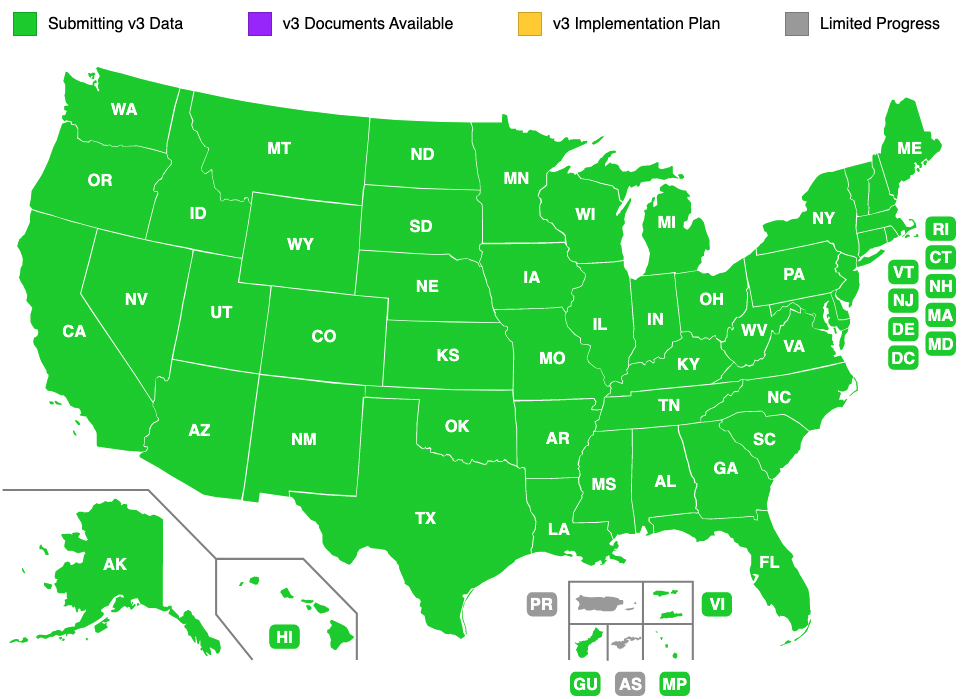NEMSIS Data Update
NEMSIS DATA UPDATE
Each month, the National Emergency Medical Services Information System (NEMSIS) Technical Assistance Center (TAC) shares an activity report which highlights achievements that are but small glimpses of the efforts underway to continually improve the collection, analysis, and use of EMS data.
According to the interactive V3 State Map on the NEMSIS website, 53 participating states and territories now regularly submit data to the National EMS Database, up from 47 a year ago. Data submissions in 2021 totaled nearly 49 million activations, a substantial increase from the 2020 total of approximately 43 million. These submissions contributed to a total of over 168 million unique records in the NEMSIS v3 standard database by year’s end.
The National Highway Traffic Safety Administration (NHTSA) continues to collaborate with state EMS officials to increase submission of state and local data to the National EMS Database. In 2009, a little over 2,000 EMS agencies from 26 states reported their data to NEMSIS. By 2020, the number of reporting states had doubled, and today there are almost 14,000 reporting agencies. Joining the national effort in collecting EMS data will advance the goal of improving patient care and safety with improvements informed by the data.
With that goal in mind, NHTSA, which funds and manages NEMSIS, is working with states and territories on updating their data use agreements to begin including data on incident locations, such as county and zip code. Geographical data will provide data users with critical insights into the variation among communities and EMS systems across the country. These data could also highlight where state and local EMS agencies and clinicians need additional operational support.
EMS leaders and researchers aren’t the only ones excited to have this information. In October 2021, the U.S. Department of Health and Human Services asked NHTSA’s Office of Emergency Medical Services (EMS) to include more detailed geographical data in the NEMSIS database, believing that it could enhance their public health monitoring strategies and inform improved public health practices.
“Consistent, timely data allows EMS agencies to better protect the public, conduct public health surveillance, and identify public health issues,” said Eric Chaney, an EMS Specialist with NHTSA’s Office of EMS who works closely with the NEMSIS TAC, state officials and other stakeholders on NEMSIS and other EMS data issues.
In 2022, the Office of National Drug Control Policy, within the Executive Office of the President, requested NEMSIS data with incident location to track the overdose epidemic impacting the United States. During the past year, we exceeded 100,000 overdose deaths, emphasizing the need to track where overdoses are occurring to target interventions.
“Our ability to coordinate our nation’s response to the overdose epidemic and support local leaders’ abilities to use their limited resources in the most impactful way possible is greatly enhanced by data available at the subnational level,” said Dr. Rahul Gupta, Director of National Drug Control Policy.
NHTSA and its Office of EMS are also committed to supporting the Department of Transportation’s National Roadway Safety Strategy and its Safe System Approach, a strategy focusing on five key objectives: safer people, safer roads, safer vehicles, safer speeds, and post-crash care. EMS systems are a critical component of post-crash care, but their operations vary greatly depending on their geography. With access to the right data, NHTSA and other officials can identify gaps and challenges in each system and support their unique needs.
“We need to utilize the data collected from patients by our EMS clinicians to help improve all elements of the system, from identifying where crashes occur to measuring injury severity, which will enable partners to target safety improvements both pre-crash and post-crash,” said Gam Wijetunge, Director of NHTSA’s Office of EMS.



